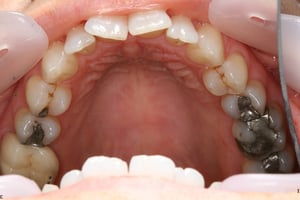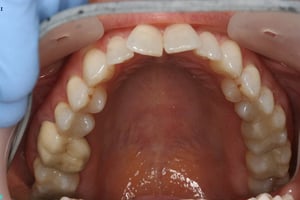
Holes in teeth have been filled for centuries. Dental fillings are used to fill openings in a tooth where the dentist has drilled out cavities and the surrounding enamel to prevent further tooth decay; the filling restores the functionality and appearance of the tooth. The filling material has significantly changed over the centuries, with the establishment of the dentistry profession and advances in learning and technology.
The first evidence of teeth with drilled holes has been dated back to 7000 BC, when skulls were found in a Neolithic graveyard in Pakistan; however, it is unlikely these drilled holes were because of dental decay and more likely a result of religious practice, where holes were drilled to release evil spirits from the body!
From 166–201 AD the Etruscans/Romans were the most advanced dentists of the ancient world; they used gold to fill teeth and even made artificial crowns. Early records of fillings are also found in Chinese, Egyptian and Greek culture. Around 700 AD, an old Chinese medical text mentioned using a silver paste to fill teeth, and since then teeth have been filled with an assortment of materials, including stone chips, resin, wood and cork, with little or no anaesthesia!
The quest for the perfect filling material continued for several centuries. The first significant advance was the discovery that hot metallic leaves of gold, silver, tin and lead could be hammered to fill cavities; however, this was a slow and expensive process. The next significant advance was the development of amalgam fillings in the nineteenth century.
The early 1800s saw the advent of the dental chair and dental drill. Various metals were used for fillings, including gold, platinum, silver and lead. Often teeth were extracted rather than filled if the filling material was too expensive. Tin was used as a filling material in the 1820s and was a cheap and therefore popular option.
In the 1830s Louis Regnart found that adding mercury to base metals created a substance that did not need to be heated and could be used to fill teeth while soft then left to harden. In 1833, the Englishmen Edward Crawcour and his nephew Moses Crawcour brought this new amalgam filling to the USA. Despite great controversy over the mercury content of this new filling material, people were not showing any signs of sickness after treatment, and its low cost made it the most popular choice for dental fillings.
Although the proportion of the silver, tin, copper, zinc and mercury components have changed over the years, dental amalgams remain a popular choice for filling teeth as they are strong and long lasting.
Nowadays there are options for patients who want to avoid the metallic look or mercury content of amalgam fillings. Developments in filling materials include:
The glass ionomer filling material is made up of acrylic acids and glass powder, and requires less tooth to be removed than for amalgam fillings. It releases a small amount of fluoride, which provides protection against decay. However, it has a low resistance to fracture. The resin ionomer is a filling material made up of acrylic acids, acrylic resin and glass filler; it has a low to moderate resistance to fracture.
Both types of ionomer are tooth-coloured but lack the translucency of enamel. They wear quickly when placed on chewing surfaces, so should only be used for small non-bearing fillings between the teeth and on the root surfaces of teeth.
Porcelain inlays or onlays are made of a feldspar quartz mixture, which when laminated or bonded onto the tooth is extremely strong and durable. However, they are not immediate like other filling materials, and need to be made by a highly skilled dental technician to fit the cavity precisely. A temporary filling is put in place while the porcelain filling is being made. The process takes between one to two weeks, but is a long-lasting option.
Gold can be easily shaped to accurately fit the cavity needing to be filled. It is very smooth, which means that the opposing teeth are not worn away. However, gold fillings are not commonly used; they are expensive, and the alternative modern fillings offer good cosmetic results.
Composite-resin fillings are made from a resin-based substance and an inorganic filler, which gives the composite wear resistance and translucency. The main advantage of a resin composite over traditional materials such as amalgam is improved aesthetics; composites can be closely matched to the colour of your teeth to enable near-invisible restoration. They chemically bond to the tooth surface, which strengthens the tooth without requiring the extent of drilling that amalgam fillings need. Composite fillings can be used to repair chipped, broken or worn teeth, and are durable and discreet.


Before and after old silver amalgam fillings being replaced, due to deterioration, with tooth-coloured resin composite.
At Elmsleigh House Dental Clinic we use resin composite fillings to match the colour of your teeth and ensure a long-lasting and natural-looking result. We also offer porcelain crowns, inlays and onlays as successful options for repairing cracked, broken, decayed or heavily filled teeth. They are hardwearing and can be colour-matched perfectly to your own teeth.
If you would like to discuss replacing your old amalgam fillings or for any dental needs, you can call our Welcome Team on 01252 713797.
